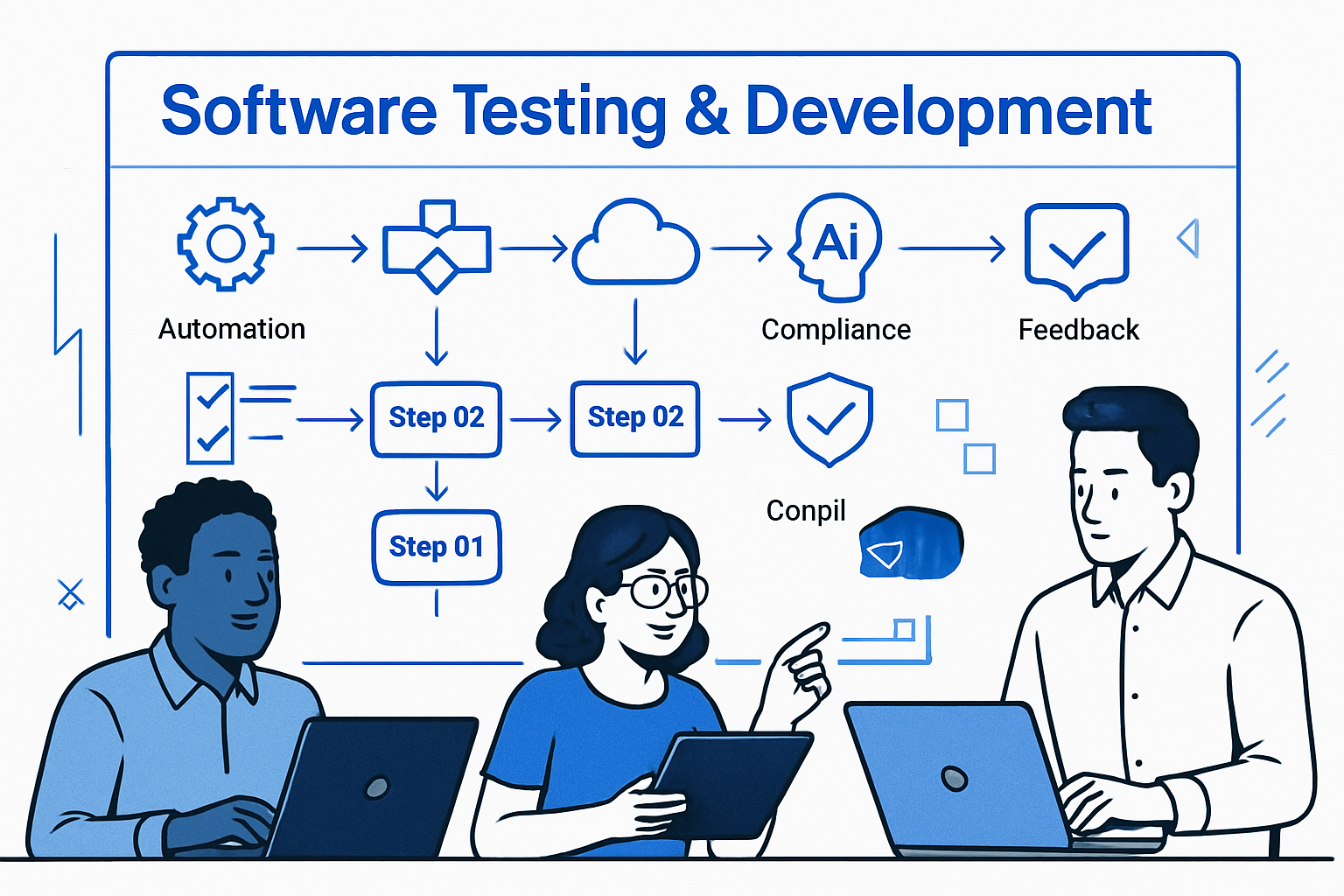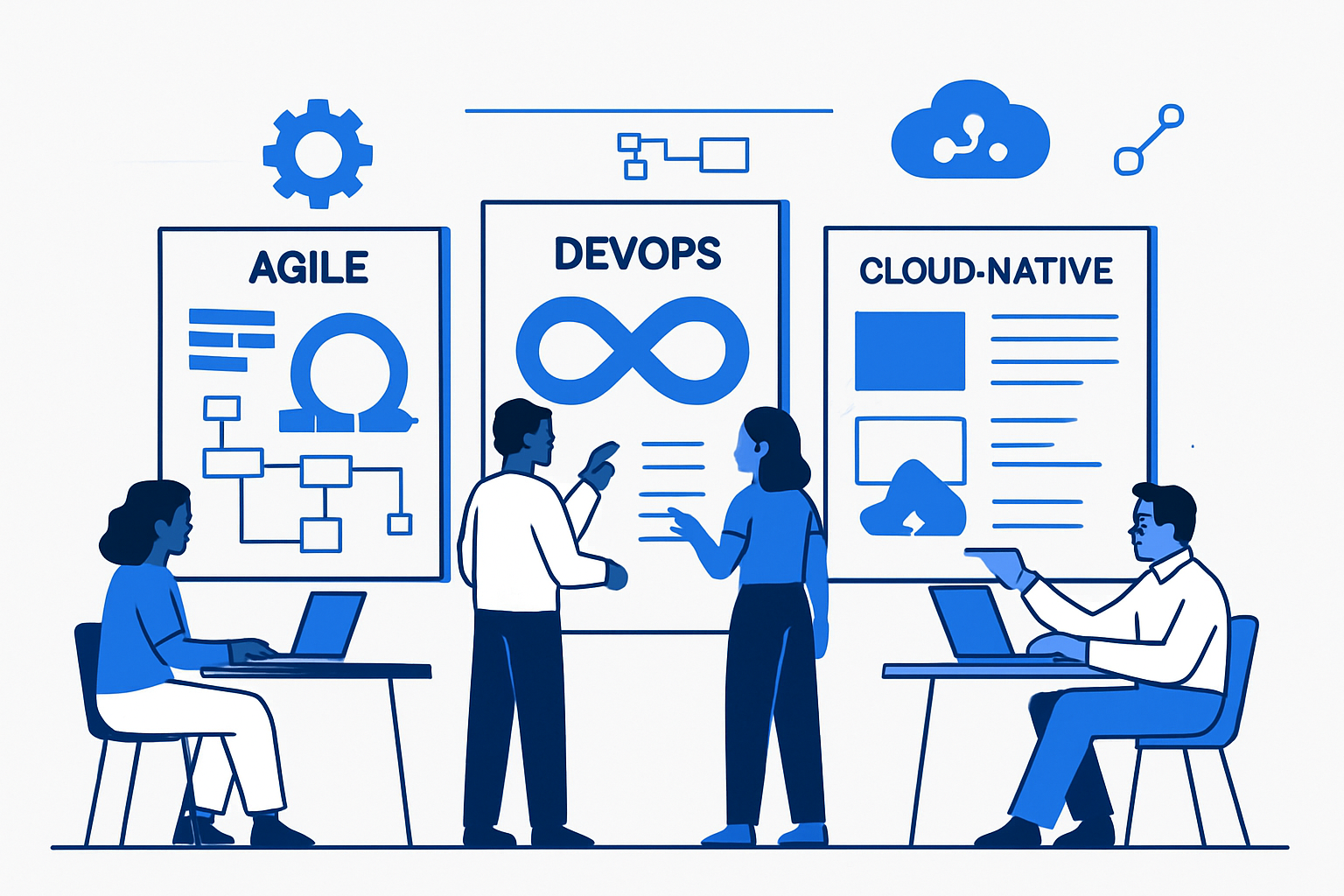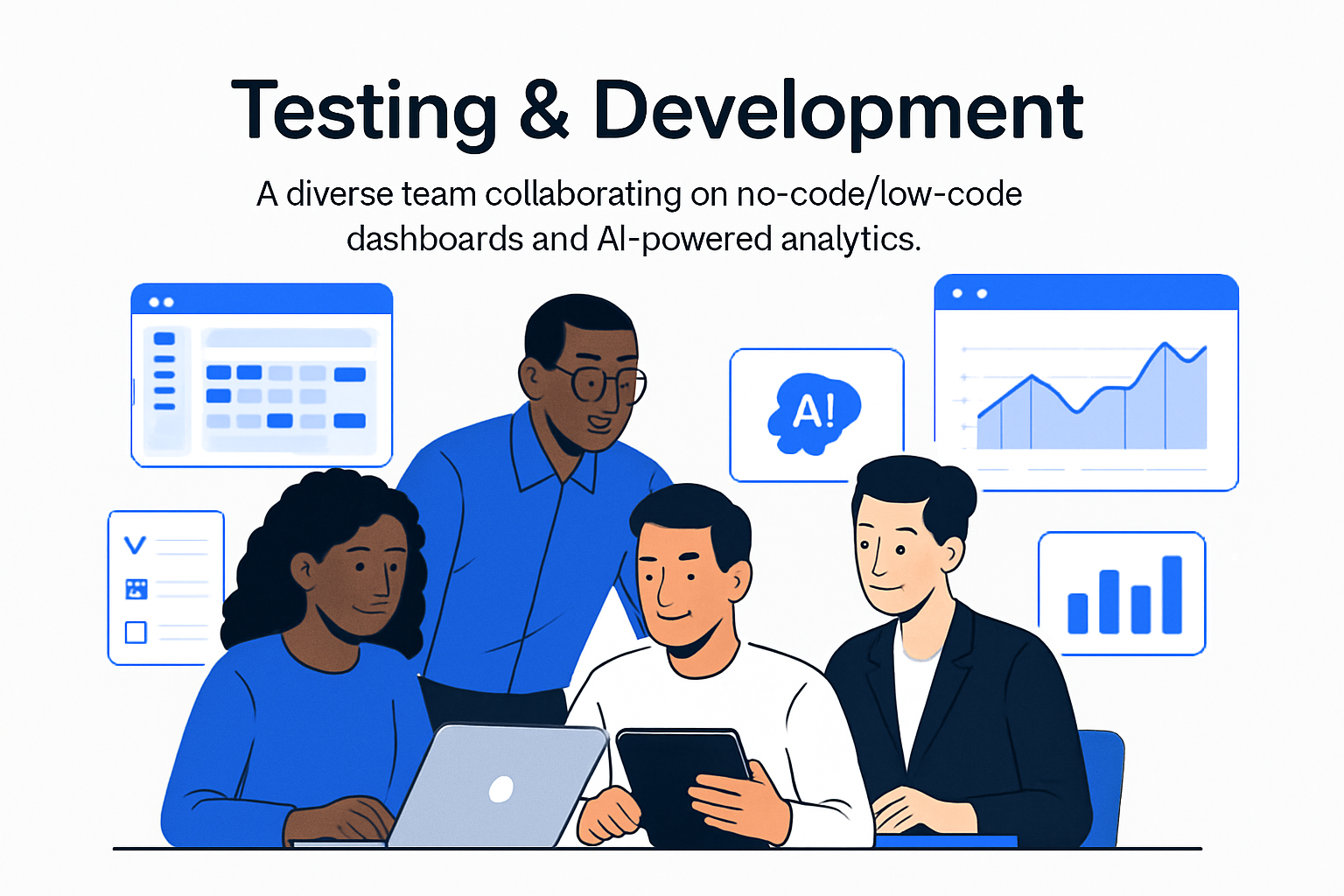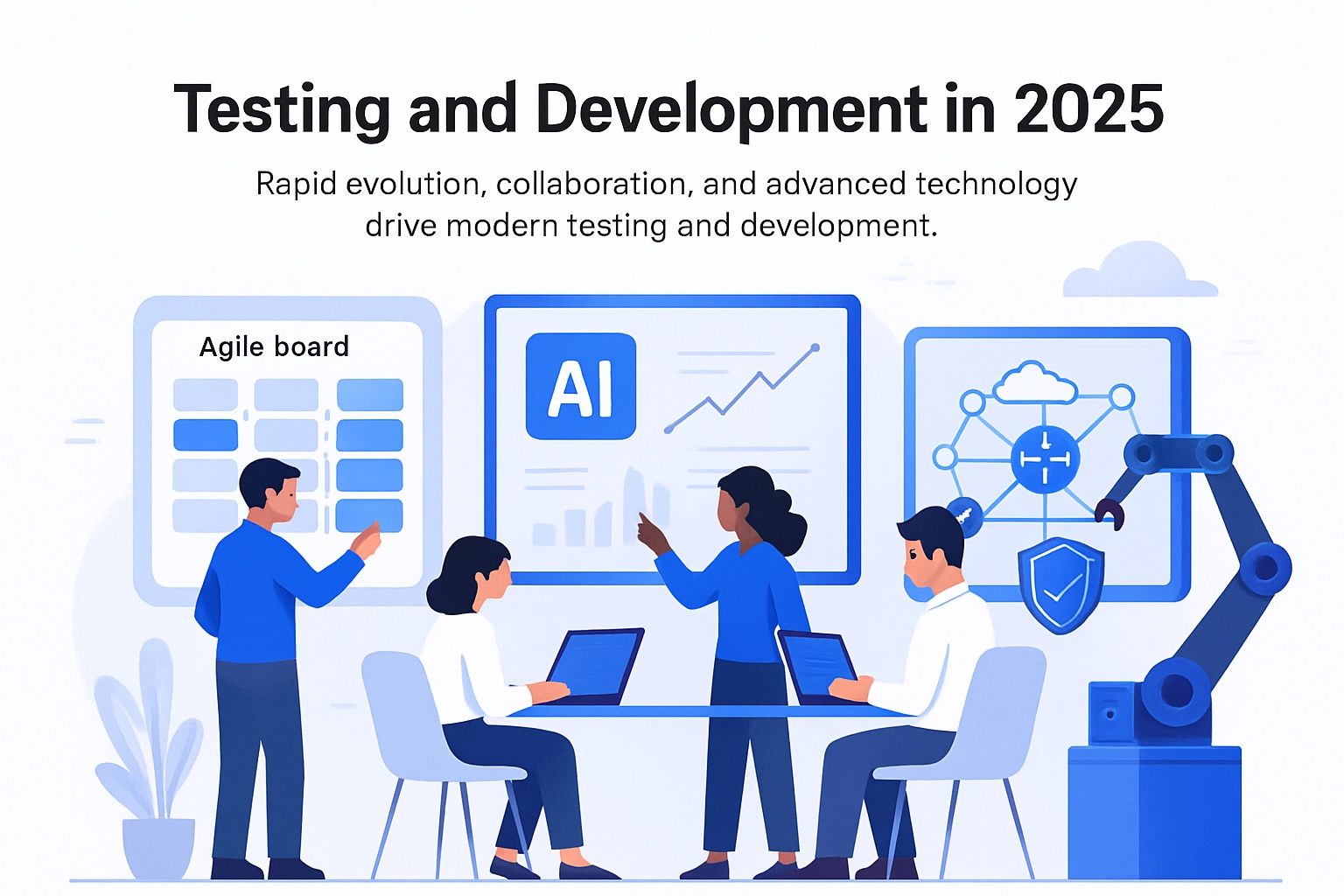Software testing and development are changing faster than ever in 2025. The push for digital transformation makes them crucial for businesses trying to stay ahead.
Teams now face new tools, smarter methodologies, and higher user expectations. Mastering these changes means faster releases, better quality, and happier customers—all while saving costs.
This guide walks you step-by-step through the essentials. You'll discover the latest methodologies, must-have tools, proven testing processes, the impact of AI and no-code platforms, and what the future holds.
Ready to optimize your workflow? Dive in and unlock the blueprint for success.
The Evolving Landscape of Testing and Development in 2025
The world of testing and development is experiencing a seismic shift in 2025. New technologies, evolving methodologies, and shifting user expectations are driving unprecedented change. As businesses race to innovate, mastering modern testing and development practices is essential to stay ahead.
Key Trends Shaping the Industry
The landscape of testing and development is being shaped by several pivotal trends:
These trends are fundamentally redefining how testing and development teams operate, making adaptability a crucial asset.
Challenges and Opportunities
While the advancements in testing and development bring exciting prospects, they also introduce new hurdles:
A notable case study comes from a fintech company that reduced bugs by 40% after integrating AI-driven testing solutions. This highlights the immense opportunity for organizations to harness innovation for measurable gains in testing and development.
Essential Skills for Modern Developers and Testers
Success in testing and development today demands a blend of technical and soft skills:
Professionals who embrace these skills position themselves and their organizations to thrive. By focusing on both technology and teamwork, teams can build robust, future-ready testing and development workflows.
Step-by-Step Guide to Modern Testing Processes
Staying ahead in testing and development requires not only the right mindset but also a systematic approach. The modern landscape demands clear strategies, up-to-date tools, and a blend of automation and human insight. This step-by-step blueprint will help you optimize your workflows and achieve higher quality releases, every time.

Planning and Scoping Your Testing Strategy
Every successful testing and development cycle starts with a robust plan. Define precise objectives, requirements, and metrics for measuring success. Without a clear scope, teams risk missing critical defects or wasting resources.
Start by identifying your target platforms, devices, and user personas. This ensures comprehensive coverage and aligns your efforts with real-world needs. Use risk assessment to prioritize test cases—focusing on areas with the highest impact.
A test matrix can help visualize coverage gaps and overlaps. For example, mapping features against browsers and devices gives clarity and confidence. According to Forrester (2024), 85% of high-performing teams invest in test planning upfront, leading to smoother releases.
Key Steps:
Taking time to plan upfront in testing and development saves headaches later and builds a foundation for quality.
Test Automation: Tools, Frameworks, and Best Practices
Automation is a game-changer in modern testing and development. It accelerates release cycles, reduces manual effort, and catches regressions early. The right tools and practices make all the difference.
Popular frameworks like Selenium, Cypress, and Playwright offer robust support for web and mobile automation. Integrating these tools into CI/CD pipelines ensures tests run automatically with every code change. This leads to faster feedback and safer deployments.
ToolBest ForKey FeaturesSeleniumWeb appsCross-browser, open sourceCypressFront-endReal-time reloads, fastPlaywrightModern appsMulti-browser, flexible APIs
Writing maintainable, reusable test scripts is crucial. Focus on modular design, clear naming, and regular reviews. Balance automated and manual testing—automation excels in regression, while manual testing uncovers unique edge cases.
AI-driven tools are transforming this area. They help with smart test case generation, faster bug detection, and predictive analytics. For a deeper look at how AI impacts quality assurance, see AI-Driven Tools in Modern Software Quality Assurance.
A SaaS company, for example, reduced regression testing time by 60% after adopting robust automation. Regularly update your scripts to match evolving features and avoid test rot.
Manual Testing: When and Why It Still Matters
Despite advances in automation, manual testing remains vital in testing and development. Human testers excel at exploratory testing, uncovering usability and edge-case issues that scripts often miss.
Exploratory testing is invaluable for new features or unfamiliar workflows. User acceptance testing (UAT) ensures the product meets business needs and real user expectations. Beta programs can reveal real-world bugs and user feedback not seen in controlled environments.
Accessibility and compliance checks often require manual review to confirm standards like WCAG or ADA are met. Automated scripts may flag issues, but human judgment is essential for nuanced scenarios.
When to Prefer Manual Testing:
A real-world example: A finance app detected critical UX bugs during a manual test session, which automation had overlooked. Manual testing and development activities are essential for a well-rounded quality strategy.
Performance, Security, and Compliance Testing
Performance, security, and compliance are pillars of robust testing and development. Load and stress testing ensure your app can handle real-world demand without crashing or slowing down.
Security testing includes vulnerability scans and penetration tests to uncover exploitable flaws. With cyber threats on the rise, these checks are no longer optional. Compliance testing verifies adherence to regulations like GDPR or HIPAA, protecting both users and the business.
Testing TypePurposeCommon ToolsLoad/StressScalability, reliabilityJMeter, GatlingSecurityVulnerability, resilienceOWASP ZAP, BurpComplianceRegulatory adherenceCustom scripts
Capgemini (2024) reports that 55% of organizations now cite compliance as a top priority in their testing and development cycles. Regular audits and documentation are key to passing regulatory checks and avoiding penalties.
Continuous monitoring and proactive improvement in these areas help maintain trust and system integrity.
Reporting, Feedback, and Continuous Improvement
The final step in effective testing and development is capturing results and learning from every cycle. Reliable defect tracking tools, such as Jira or Azure DevOps, streamline the reporting process and keep teams aligned.
Analytics tools help with root cause analysis, revealing patterns behind recurring bugs or failures. Use feedback loops—like sprint reviews and retrospectives—to gather insights from testers, developers, and stakeholders.
Feedback Loop Essentials:
Iterative improvement is the heartbeat of testing and development. By closing the loop and acting on feedback, teams build more resilient, user-friendly products.
Essential Development Methodologies and Frameworks
Navigating the dynamic field of testing and development in 2025 means understanding the frameworks that drive modern teams. Methodologies like Agile, DevOps, TDD, and cloud-native strategies are no longer optional—they’re the pillars supporting high-quality releases and rapid innovation. Let’s break down what’s powering today’s most successful projects.

Agile, Scrum, and Kanban in 2025
Agile, Scrum, and Kanban continue to define how teams approach testing and development. Agile’s iterative cycles and focus on stakeholder feedback keep projects aligned with shifting business needs. Scrum organizes work into sprints, driving consistent progress and quick pivots. Kanban visualizes workflows, highlighting bottlenecks and optimizing delivery speed.
Why are these methods thriving?
A recent study found that Agile teams deliver 30% more features per release, showing measurable gains in productivity. If your testing and development goals focus on speed and adaptability, these frameworks are essential.
Methodology Comparison Table
MethodologyBest ForStrengthsAgileProduct evolutionFlexibility, feedbackScrumSprint deliveryStructure, team focusKanbanContinuous flowVisibility, efficiency
DevOps and CI/CD Integration
DevOps and CI/CD have revolutionized testing and development by bridging the gap between coding and deployment. DevOps promotes a culture of shared responsibility, blurring the lines between developers and operations. CI/CD pipelines automate code integration, testing, and release, reducing errors and accelerating time to market.
What’s new in 2025? AI and automation are now essential, streamlining everything from code reviews to deployment. For a deeper dive into how AI is transforming these processes, see AI-Assisted Software Development.
Best practices include:
With DevOps, testing and development teams can release updates faster while maintaining stability.
Test-Driven Development (TDD) and Behavior-Driven Development (BDD)
TDD and BDD are redefining software quality in testing and development. TDD requires writing tests before code, ensuring every feature is validated from the start. This method reduces bugs and technical debt.
BDD takes this further by describing tests in natural language, aligning technical work with business goals. This clarity bridges gaps between testers, developers, and non-technical stakeholders.
Key benefits:
For example, TDD has helped e-commerce teams cut post-release defects by half. If your testing and development process aims for reliability and communication, TDD and BDD are invaluable.
Microservices and Cloud-Native Development
Microservices and cloud-native architectures are at the forefront of modern testing and development. Microservices break applications into independent services, allowing teams to scale, deploy, and test components separately. Cloud-native approaches leverage the flexibility of cloud platforms, supporting rapid experimentation and resilience.
Advantages:
However, these patterns come with challenges: orchestrating multiple services, ensuring consistent monitoring, and managing complex testing scenarios. Successful teams invest in robust automation and smart monitoring to keep their testing and development pipelines efficient.
The Impact of No-Code, Low-Code, and AI on Testing and Development
The landscape of testing and development is transforming at breakneck speed. No-code and low-code platforms, along with powerful AI tools, are opening new doors for teams of all sizes. Understanding these shifts is crucial for anyone seeking to stay ahead in testing and development.

The Rise of No-Code and Low-Code Platforms
No-code and low-code platforms are revolutionizing testing and development by enabling faster prototyping and empowering non-developers to build applications. According to Statista, the no-code market is expected to reach $45 billion by 2025, highlighting its explosive growth.
These platforms allow teams to create MVPs, automate workflows, and test ideas without deep coding expertise. For testing and development, this means more rapid iterations and the ability to respond quickly to user feedback.
Key use cases include:
By lowering barriers, no-code and low-code tools democratize testing and development, making innovation accessible to broader teams. However, understanding their limitations is essential for building scalable, long-term solutions.
AI-Powered Testing and Development
AI is redefining testing and development by automating code generation, bug detection, and even predicting future issues based on analytics. Machine learning models can review code, suggest fixes, and optimize test coverage, significantly reducing manual effort.
For example, AI-based testing tools have shortened test cycles by 35% for some retail apps. Predictive analytics help teams focus on likely problem areas, boosting quality and efficiency. However, AI comes with its own set of challenges, such as transparency and ethical considerations.
For those interested in a deeper dive, AI's Impact on Traditional Software Development offers valuable insights into how AI is transforming core development and testing practices.
The integration of AI into testing and development is not just a trend—it's quickly becoming a necessity for competitive teams.
Integrating No-Code and AI into Enterprise Workflows
Bringing no-code, low-code, and AI into enterprise workflows requires thoughtful planning. Teams should focus on best practices to maximize benefits while minimizing disruption.
Best practices for adoption:
Upskilling staff is vital, as testing and development tools are evolving rapidly. Organizations should foster a culture of continuous learning and experimentation, encouraging teams to explore new platforms and AI-driven solutions.
Successful integration can streamline testing and development, reduce bottlenecks, and increase collaboration across departments.
Potential Risks and How to Mitigate Them
Despite the advantages, no-code, low-code, and AI introduce risks to testing and development. Security and compliance are top concerns, especially with sensitive data and third-party platforms.
Common risks include:
RiskMitigation StrategySecurity flawsRegular audits, strong access controlsCompliance issuesChoose platforms with certificationsTechnical debtDocument workflows, review architectureVendor lock-inFavor open standards, plan for migration
Teams should proactively address these risks by establishing clear governance and regularly reviewing tools and processes. With the right approach, organizations can harness the power of modern testing and development while safeguarding their assets and reputation.
Future Trends and Innovations in Testing and Development
The world of testing and development is on the cusp of a revolution, driven by new technologies and changing business demands. Staying ahead means understanding the innovations shaping tomorrow’s workflows. Let’s explore the trends that will define the future of testing and development.
Predictive Testing and Autonomous QA
AI is transforming testing and development by enabling predictive testing and autonomous QA. These tools use machine learning to analyze historical data, spot defect patterns, and suggest optimal test cases.
With autonomous systems, teams spend less time on repetitive tasks and more on value-driven activities. For a deeper dive into AI-driven quality assurance, check out this comprehensive guide on AI in software testing.
Shift-Left and Shift-Right Testing Strategies
Shift-left and shift-right approaches are now fundamental in testing and development. Shift-left means integrating testing earlier in the software development lifecycle, catching defects before they become costly.
These strategies reduce risk and enable faster feedback loops. By embedding testing and development throughout the process, organizations can consistently deliver higher quality releases.
The Role of Cloud, Edge, and IoT in Testing
Testing and development now extend beyond traditional environments, embracing cloud, edge, and IoT platforms. This expansion brings new challenges like data volume, latency, and connectivity issues.
ChallengeSolutionData OverloadScalable cloud infrastructureLatency IssuesEdge computing optimizationDevice DiversityAutomated compatibility tests
Teams must design robust testing and development strategies to handle distributed, real-time scenarios. This ensures reliability across a growing landscape of devices and services.
Evolving Roles: From QA Engineers to Quality Advocates
The roles within testing and development are evolving rapidly. QA professionals are shifting from traditional testers to quality advocates embedded in cross-functional teams.
This evolution fosters a culture where testing and development are seamlessly integrated, driving better outcomes for customers and businesses alike.
Preparing for the Next Wave of Disruption
Emerging technologies like quantum computing, blockchain, and new programming paradigms are set to reshape testing and development. Staying ahead requires a proactive mindset.
By preparing for disruption, teams can future-proof their testing and development practices and remain leaders in a dynamic industry.
If you’re inspired by the latest trends in testing and development and ready to put these strategies into action, why wait months to launch your next big idea? With today’s no-code and AI platforms, it’s possible to move from concept to MVP faster than ever—without sacrificing quality or breaking the bank. If you want to see just how quickly you can bring your product vision to life, check out our guide on how to Launch Your MVP in Weeks, Not Months. Let’s turn those ideas into reality together!




About Big House
Big House is committed to 1) developing robust internal tools for enterprises, and 2) crafting minimum viable products (MVPs) that help startups and entrepreneurs bring their visions to life.
If you'd like to explore how we can build technology for you, get in touch. We'd be excited to discuss what you have in mind.
Other Articles
Discover everything beginners need to know about software designers in 2025. Learn roles, skills, tools, and career tips to start your design journey today.
Explore the ultimate flutter artificial intelligence guide for 2026 Learn to build smarter apps with AI trends integration steps top tools and future strategies
Stay ahead with the latest Soundhound news Explore 2025 updates on AI voice tech product launches stock trends and expert insights for investors and developers

